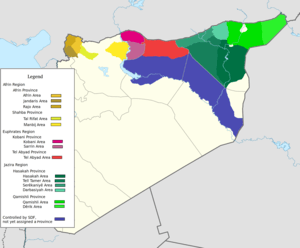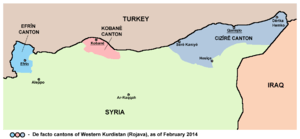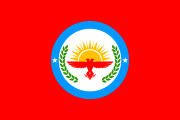Euphrates Region
| Euphrates Region Herêma Firatê | |||
|---|---|---|---|
| One of three de facto regions of the Democratic Federation of Northern Syria | |||
| |||
 The three regions of the DFNS: Afrin Region (orange), Euphrates Region (red) and Jazira Region (green). | |||
| Country |
| ||
| Governorate | Aleppo, Raqqa | ||
| De facto Administration | Democratic Federation of Northern Syria | ||
| Autonomy declared | January 27, 2014 | ||
| Administrative center | Kobanî | ||
| Government | |||
| • Prime Minister | Enver Muslim | ||
| Population | |||
| • Estimate (2004[1]) | 322,227 | ||
| Time zone | UTC+2 (EET) | ||
| • Summer (DST) | UTC+3 (EEST) | ||
| Area code | +963 21 | ||

Euphrates Region, formerly Kobanî Canton, (Kurdish: Herêma Firatê, Arabic: إقليم الفرات, Classical Syriac: ܦܢܝܬܐ ܕܦܪܬ, translit. Ponyotho d'Prat), is the central of three regions of the de facto autonomous Democratic Federation of Northern Syria, factually comprising Ayn al-Arab District of the Aleppo Governorate, Tell Abyad District of the Raqqa Governorate, and the westernmost tip of Nahiya Ras al-Ayn of the Ras al-Ayn District of Al-Hasakah Governorate. Euphrates Region unilaterally declared autonomy in January 2014 and since de facto is under direct democratic government in line with the polyethnic Constitution of Rojava.
The regional capital city is Kobanî, which was under siege between October 2014 and January 2015 by ISIL.[2]
The region has two subordinate cantons, the Kobani canton consisting of the Sarin area (with the al-Jalabiya district subordinate to it) and the Kobani area (with the Şêran and the Qenaya districts subordinate to it), as well as the Tel Abyad canton (with the Ain Issa and Suluk districts subordinate to it).[3]
Geography
The region is bordered by Euphrates river to the west, Urfa Province of Turkey to the north, Jazira Region to the east, al-Thawrah District and Raqqa District of the Raqqa Governorate to the south and south-east respectively. At latitude approximately 36 and a half degrees north, its landscape consists of plains and low hills, rivers being Euphrates and Balikh. Part of the Fertile Crescent, its climate is mostly "warm mediterranean" on the Köppen climate classification, as opposed to the colder, semi-arid regions in its and further to the south and east.[4]
Demographics
The current population of Euphrates Region is unknown due to substantial refugee movements; however, the population of the territory before 2014 was estimated at roughly 400,000, with an ethnic Kurdish majority. Due to intense fighting at least three-quarters of the population fled across the border to Turkey in 2014;[5] however, many returned in 2015.[6]
Cities and towns with more than 10.000 inhabitants according to the 2004 Syrian census are Kobanî (44,821) and Tell Abyad (14,825).
History
The present Kurdish populated area on the left bank of the Euphrates was settled by Kurdish tribes at the beginning of the 17th century.[7] In modern post-independence Syria, the Kurdish society of the region was subject to heavy-handed Arabization policies by the Damascus government.[8] In the course of the Syrian Civil War and the Rojava conflict, Damascus government forces withdrew from the area, and on 27 January 2014 an autonomous Kobanî Canton under the Constitution of Rojava was declared and institutions established.
In July 2013, the Islamic State of Iraq and the Levant (ISIL) began to forcibly displace Kurdish civilians from towns in Raqqa Governorate. After demanding that all Kurds leave Tell Abyad or else be killed, thousands of civilians, including Turkmens and Arabs, fled on 21 July. Its fighters looted and destroyed the property of Kurds, and in some cases, resettled displaced Sunni Arab families from the an-Nabek District (Rif Damascus), Deir ez-Zor and Raqqa, in abandoned Kurdish homes. A similar pattern was documented in Tel Arab and Tal Hassel in July 2013. As ISIL consolidated its authority in Raqqa, Kurdish civilians were forcibly displaced from Tel Akhader, and from the immediate Kobanî area, in March and September 2014, respectively.[9]
Euphrates Region has seen fighting with the Islamic State of Iraq and the Levant (ISIL) since 2014. In September 2014, ISIL launched a major assault against Euphrates Region, seizing more than 100 Kurdish villages.[10][11] As a consequence of the ISIL occupation, up to 200,000 Kurdish refugees fled from the Euphrates Region to Turkey, allowed in only under the condition that they leave vehicles or livestock behind.[10][12] While committing massacres and kidnapping womenen the seized villages,[11] ISIL forces were not able to occupy the entire region, as the People's Protection Units (YPG) and Women's Protection Units (YPJ) forces successfully put up stiff resistance in the city of Kobanî. After weeks of isolation as a result of Turkey blocking arms and fighters from entering the city, the US-led coalition finally began to target the ISIL assault forces with airstrikes. This move helped the YPG/YPJ to force ISIL to retreat from the city, and much of the surrounding region was retaken by Kurdish forces.[13] After the successful summer 2015 Tell Abyad offensive of YPG/YPJ forces against ISIL, municipalities there voted to join the autonomous Kobanî Canton administration,[14] creating the region in its contemporary shape.
Airmen from the 621st Contingency Response Wing of the United States Air Force have expanded an airstrip south of Kobanî for use by U.S. forces.[15][16]
Politics and administration
Kobanî's Legislative Assembly has appointed a president, two deputies and 22 ministers to rule Euphrates Region. Its prime minister is Enver Müslim. According to the constitutional Charter of the Social Contract, the Kobanî Canton's Legislative Assembly on its 27 January 2014 session declared autonomy. The assembly elected Enver Müslim prime minister, who appointed Bêrîvan Hesen and Xalid Birgil his deputies. The government is lobbying for a humanitarian corridor, and the creation of new refugee camps inside Syria, where they can help with rebuilding.[17]
List of executive officers
| Name | Party | Office | Elected | Notes | |
|---|---|---|---|---|---|
| Enver Müslim | PYD | Prime Minister | 2014 | ||
| Bêrîvan Hesen | PYD | Deputy Prime Minister | 2014 | ||
| Xalid Birgil | Syrian Kurdish Democratic Party PDKS | Deputy Prime Minister | 2014 | ||
| Îbrahîm Kurdo | N/A | Foreign Minister | 2014 | ||
| Îsmet Şêx Hesen | N/A | Minister of Defense | 2014 | ||
| Ehmed Osman Dadilî | N/A | Interior Minister | 2014 | ||
| Mistefa Ebdî | N/A | Minister of Regional Commissions, Councils and Planning |
2014 | ||
| Eliya Sîdî | N/A | Minister of Finance | 2014 | ||
| Mehmud Bişirî Beşar | N/A | Minister of Labor and Social Security | 2014 | ||
| Hisên Mehemed Elî | N/A | Minister of Education: | 2014 | ||
| Gulistan Etî Bikî | Syrian Kurdish Democratic Party PDKS | Minister of Agriculture | 2014 | ||
| Dr. Neesan Ehmed | N/A | Minister of Health | 2014 | ||
| Mehmud Bozan Mislim | Syrian Kurdish Democratic Party PDKS | Minister of Trade and Economy | 2014 | ||
| Mehemed Şeban | N/A | Minister of Martyrs’ Families | 2014 | ||
| Ebdilrezaq Elî | N/A | Minister of Culture | 2014 | ||
| Riyad Temo Mistefa | N/A | Minister of Transportation | 2014 | ||
| Welat Derwîş Derwîş | N/A | Minister of Youth and Sport | 2014 | ||
| Mîdya Hemo Genco | N/A | Minister of History and Tourism | 2014 | ||
| Mehemed Zahir Mistefa | N/A | Minister of Religious Affairs | 2014 | ||
| Wehîde Umer | N/A | Minister of Women and Family Affairs | 2014 | ||
| Faruk Şahîn | N/A | Minister of Human Rights | 2014 | ||
| Ehmed Daban | N/A | Minister of Supervision | 2014 | ||
| Şevîn Mehmud | N/A | Minister of Information | 2014 | ||
| Ewas Xelîl Elî | N/A | Minister of Justice: | 2014 | ||
| Fazil Mistefa Ehmed | N/A | Minister of Energy | 2014 | ||
Economy
The economy of the region is mainly based on agriculture, with the invention of greenhouse agriculture since the constitution of Euphrates Region.[18][19]
While there is no significant industrial area in Euphrates Region, there is a notably large number of cement production facilities.[20]
Electricity is supplied by Tishrin Dam on the Euphrates, within Euphrates Region; apart from that, electricity is produced by diesel generators.[20]
Around the region, but in particular in the city of Kobanî, economic priorities are the continuing war and reconstruction, including help for returning refugees.[6] Most of the city and surrounding villages have been destroyed or badly damaged, and there is a danger of landmines.[6] As of January 2017, in spite off the paucity of resources available and the embargoes imposed on the region, the rebuilding process has made considerable progress; over 70% of damaged roads have been restored, two hospitals rebuilt and another two added, and the 15 schools rebuilt now host over 50,000 students.[21]
Education
Like in the other DFNS regions, primary education in public schools is initially instructed according to each student's mother tongue, be it Kurdish or Arabic. Students then begin to learn their second language of Kurdish or Arabic, as well as additional instruction of English. This is due to Rojava's stated goal of students achieving bilingualism in both Kurdish and Arabic by secondary schooling.[22][23] Curricula are a topic of continuous debate between the regions' Boards of Education and the Syrian central government in Damascus, which partly pays the teachers.[24][25][26][27] With Euphrates Region being home to a Syrian Turkmen minority, school education bilingual in Turkish and Arabic has also been made available.[28]
The federal, regional and local administrations in Rojava put much emphasis on promoting libraries and educational centers, to facilitate learning and social and artistic activities. One cited example is the May 2016 established Rodî û Perwîn Library in Kobani.[29]
Euphrates Region has no institution of higher education.
See also
References
- ↑ "General Census of Population and Housing 2004" (PDF) (in Arabic). Syrian Central Bureau of Statistics. Archived from the original (PDF) on 8 December 2015. Retrieved 15 October 2015. Also available in English: "2004 Census Data". UN OCHA. Retrieved 15 October 2015.
- ↑ "The Constitution of the Rojava Cantons". Personal Website of Mutlu Civiroglu.
- ↑ http://en.hawarnews.com/euphrates-region-within-the-administrative-division/
- ↑ "Updated world map of the Köppen-Geiger climate classification". European Geosciences Union.
- ↑ "Syria says giving military support to Kurds in Kobani". The Daily Star. Agence France-Presse. October 22, 2014. Retrieved October 14, 2014.
- 1 2 3 "The dangerous rebuilding of Kobani".
- ↑ Jordi Tejel (2008). Syria's Kurds: History, Politics and Society. Routledge. pp. 10–. ISBN 978-1-134-09643-5.
- ↑ "SYRIA: The Silenced Kurds; Vol. 8, No. 4(E)". Human Rights Watch. 1996.
- ↑ "Report of the Independent International Commission of Inquiry on the Syrian Arab Republic: Twenty-seventh session". UN Human Rights Council.
- 1 2 Constanze Letsch (22 September 2014). "Isis onslaught against Kurds in Syria brings 'man-made disaster' into Turkey". the Guardian.
- 1 2 "ISIL seizes 21 Kurdish villages in northern Syria, close in on Kobane". AFP/Reuters. 18 September 2014.
- ↑ Ayla Albayrak (17 October 2014). "Hundreds Wait for Kobani Fighting to End, Risking Lives at Border". Wall Street Journal.
- ↑ "YPG official: Airstrikes not enough to protect Kobani". Al-Monitor. 14 October 2014.
- ↑ Tom Perry (21 October 2015). "Town joins Kurdish-led order in Syria, widening sway at Turkish border". Reuters. Retrieved 2016-10-25.
- ↑ Copp, Tara (April 3, 2017). "US expands air base in northern Syria for use in battle for Raqqa". Stars and Stripes.
- ↑ Abazović, Aldin [@CT_operative] (June 10, 2017). "#UnitedStates airbase still under constriction, 35 km south of Kobani, #Syria Imagety: 06 May 2017" (Tweet) – via Twitter.
- ↑ "Kobani: destroyed and riddled with unexploded bombs, but its residents dare to dream of a new start". Guardian. 2015-01-31.
- ↑ "Preparations for "Jotkar" agricultural project". UKSSD e. V. 11 February 2016. Retrieved 2016-12-07.
- ↑ https://twitter.com/r0java/status/796666582986584064
- 1 2 "Rojava: The Economic Branches in Detail". cooperativeeconomy.info. 14 January 2017. Retrieved 16 January 2017.
- ↑ Manisha Ganguly (14 January 2017). "Raising Kobanî from Rubble". realmedia.press. Retrieved 16 January 2017.
- ↑ "Education in Rojava after the revolution". ANF. 2016-05-16. Retrieved 2016-06-10.
- ↑ "After 52-year ban, Syrian Kurds now taught Kurdish in schools". Al-Monitor. 2015-11-06. Retrieved 2016-05-18.
- ↑ "Hassakeh: Syriac Language to Be Taught in PYD-controlled Schools". The Syrian Observer. 3 October 2016. Retrieved 2016-10-05.
- ↑ "Kurds introduce own curriculum at schools of Rojava". Ara News. 2015-10-02. Retrieved 2016-05-18.
- ↑ "Revolutionary Education in Rojava". New Compass. 2015-02-17. Retrieved 2016-05-10.
- ↑ "Education in Rojava: Academy and Pluralistic versus University and Monisma". Kurdishquestion. 2014-01-12. Retrieved 2016-05-18.
- ↑ "Confederalisme democràtic: Noves classes en llengua turcmana al nord de Síria". KurdisCat. 25 October 2016. Retrieved 2016-10-29.
- ↑ "Kurds establish university in Rojava amid Syrian instability". Kurdistan24. 2016-07-07. Retrieved 2016-07-07.
External links
| Wikimedia Commons has media related to Kobanê Canton. |
- Map of majority ethnicities in Syria by Gulf2000 project of Columbia university

.svg.png)